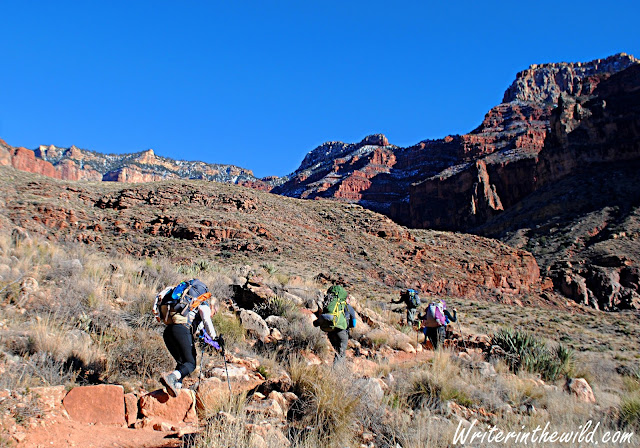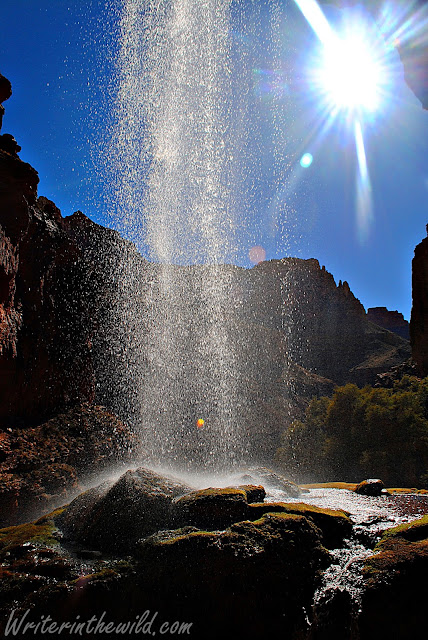Phantom Ranch is a funny place. In the middle of seemingly nowhere, at the bottom of an inconceivably huge canyon lies this little slice of civilization. There are a smattering of buildings; lodges for the ecotourist, cabins for park rangers and other staff, and of course, Phantom Ranch itself, which is more or less a cantina. We awoke on day two to the thunder of power tools and earth movers shattering that tranquil sound of the awakening desert. I wondered how the small bulldozer got there, since the only way in is by foot, boat or beast of burden. I supposed it could have came by boat, or maybe lowered by helicopter. I hung my soaked sleeping bag on a bear hang pole (see previous post) and took care of my camp. We watched the masses depart during breakfast, leaving Phantom for destination's unknown. It didn't really feel like backpacking in that place. Too many people. Too many amenities.
 |
| Ellen in "The Box". |
After a late start we left Phantom enroute to Cottonwood Camp below the north rim. Soon after departure, we entered an area on the North Kaibab Trail called "The Box". The Box is a narrow canyon flanked by towering vertical cliffs. It is notorious for being an inferno in the summer months, although in winter it was chilly since the giant rock walls prevent the sun from reaching the bottom most of the day. To me it felt like a slot canyon. The danger of falling rocks weighed on my mind the entire way through. Especially after seeing rocks fall on the adjacent wall across the creek, and climbing over various rock piles that blocked the trail as we hiked through.
 |
| On the North Kaibab Trail |
Eventually the Box opened up to sunshine and views of the snow-covered north rim. The experience was quite different than the day before because we barely saw anyone. I think we encountered only one other hiker in the Box. Between the Box and Cottonwood Camp we ran into a group of three researchers who were studying the health of native fish in Bright Angel Creek. They actually lived down there during the winter. What a sweet gig!
 |
| Climbing to Cottonwood Camp |
We made camp in a huge group site under some cottonwoods in an otherwise empty Cottonwood Camp. Luckily my sleeping bag was completely dry. Determined to stay dry and warm, I stuffed my pad inside the bivy, thinking that by sleeping on instead of in it, I could still benefit from the heat reflecting properties and not wake up drenched. I was soon lulled to sleep by the pleasing sound of the creek and a slight breeze.
 |
| Heading south on North Kaibab. |
Day 3 began with the silence and solitude one would expect from a backcountry locale in an immense wilderness like the Grand Canyon. Our plan was to return to Phantom Ranch through the Box, with a detour at Ribbon Falls. Ribbon Falls reminded me a lot of Leona Falls in the Cascades, except that in the Cascades, I had Leona Falls to myself. There were probably 20 or more people milling about Ribbon Falls when we arrived, and more arriving by the minute. Again I marveled at the amount of people so deep in the backcountry. It's a sight I had never seen before. No doubt the mule trains from the south rim, and the guide services running the river bring people to this area that wouldn't normally be here. And it's cool. I'm not complaining. If I couldn't do it myself, I would probably ride a mule too.
 |
| From behind Ribbon Falls |
We reached Phantom Ranch in time to see a large herd of mule deer milling about Bright Angel Creek. The sun was setting and I just stood and watched them as long as I could. Watching animals in the wild is always such an amazing experience. It's like a window to a new world and new relationships that few people really get to see. I wondered: Where did they come from? Where are they going? Who is the leader? How many have died this year so far? Are any pregnant? Did they get cold at night? No matter how tough we humans think we are, we ain't shit compared to a wild animal, who every night sleeps in the dirt and the mud. Who has to find food and water. Who has to walk everywhere they go. Who has to constantly be on alert for other animals that want to take what they have. As it turns out, this would not be our only encounter with mule-deer on this trip... to be continued.

No comments:
Post a Comment